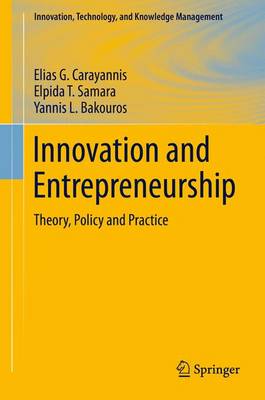Innovation, Technology, and Knowledge Management
3 primary works • 6 total works
Book 11
Cross-Cultural Knowledge Management
by Manlio Del Giudice, Elias G. Carayannis, and Maria Rosaria Della Peruta
Cross-cultural knowledge management, an elusive yet consequential phenomenon, is becoming an increasingly essential factor in organizational practice and policy in the era of globalization. In order to overcome culturally shaped blind spots in conducting research in different settings, this volume highlights how the structuring of roles, interests, and power among different organizational elements, such as teams, departments, and management hierarchies (each comprised of members from different intellectual and professional backgrounds), generates various paradoxes and tensions that bring into play a set of dynamics that have an impact on learning processes.
In this context, such questions often arise: How is knowledge shared in the multicultural organization? What problems and issues emerge? How do different mentalities affect people’s responses to new knowledge and new ideas? How can knowledge-sharing processes be improved? Under which conditions do ideas generated by units or groups of different cultural traditions have a chance of being heard and implemented?
Such questions translate into an investigation of potential managerial dilemmas that occur when different but equally valid choices create tensions in decision making. The authors draw from experiences working with a wide variety of organizations, and insights from such fields as sociology and psychology, to shed new light on the dynamics of knowledge management in the multicultural enterprise. In so doing, they help to identify both obstacles to successful communication and opportunities to inspire creativity and foster collaboration. The authors note that in order to enable organizations to transfer knowledge effectively, mechanisms for dispute settlement, mediation of cultural conflict, and enforcing agreements need to be in place.
Book 12
Promoting Balanced Competitiveness Strategies of Firms in Developing Countries
by Vivienne W L Wang and Elias G. Carayannis
Since the pioneering work of Joseph Schumpeter (1942), it has been assumed that innovations typically play a key role in firms’ competitiveness. This assumption has been applied to firms in both developed and developing countries. However, the innovative capacities and business environments of firms in developing countries are fundamentally different from those in developed countries. It stands to reason that innovation and competitiveness models based on developed countries may not apply to developing countries.
In this volume, Vivienne Wang and Elias G. Carayannis apply both theoretical approaches and empirical analysis to explore the dynamics of innovation in developing countries, with a particular emphasis on R&D in manufacturing firms. In so doing, they present an alternative to Michael Porter’s Competitive Advantage Model—a Competitive Position Model that focuses on incremental and adaptive innovations that are more appropriate than radical innovations for developing countries. Their research addresses such questions as:
- Do innovations advance the competitive positions of manufacturing firms in developing countries?
- Does the pace of innovation matter, in particular, in socio-economic and socio-political contexts?
- To what degree can national innovation systems and policies influence development?
- To what extent do a firm’s innovation commitments correlate with the protection of intellectual property rights?
- What roles do foreign direct investment and relationships with clusters and networks play?
The resulting analysis not only challenges traditional theoretical approaches to innovation, but provides suggestions for improving business practice and policymaking.
Book 13
Institutional Learning and Knowledge Transfer Across Epistemic Communities
by Elias G. Carayannis, Ali Pirzadeh, and Denisa Popescu
Over the past several decades, as the pace of globalization has accelerated, operational issues of international coordination have often been overlooked. For example, the global financial crisis that began in 2007 is attributed, in part, to a lack of regulatory oversight. As a result, supranational organizations, such as the G-20, the World Bank, and the International Monetary Fund, have prioritized strengthening of the international financial architecture and providing opportunities for dialogue on national policies, international co-operation, and international financial institutions.
Prevailing characteristics of the global economic systems, such as the increasing power of financial institutions, changes in the structure of global production, decline in the authority of nation-states over their national economy, and creation of global institutional setting, e.g., global governance have created the conditions for a naturally evolving process towards enabling national epistemic communities to create institutions that comply with global rules and regulations can control crises.
In this context, transfer of technical knowledge from the larger organizations and its global epistemic communities to member communities is becoming a policy tool to “convince” participants in the international system to have similar ideas about which rules will govern their mutual participation. In the realm of finance and banking regulation, the primary focus is on transfer of specialized and procedural knowledge in technical domains (such as accounting procedures, payment systems, and corporate governance principles), thereby promoting institutional learning at national and local levels. In this volume, the authors provide in-depth analysis of initiatives to demonstrate how this type of knowledge generated at the international organization level, is codified into global standards, and disseminated to members, particularly in the developing world, where the legal and regulatory infrastructure is often lacking.
They argue that despite the challenges, when a country intends to join the global system, its institutions and economic structures need to move toward the global norms. In so doing, they shed new light on the dynamics of knowledge transfer, financial regulation, economic development, with particular respect to supporting global standards and avoiding future crises.
Student Entrepreneurship in the Social Knowledge Economy
by Manlio Del Giudice, Maria Rosaria Della Peruta, and Elias G. Carayannis
Traditionally, the study of entrepreneurial behavior focuses on such factors as (i) the personality characteristics that distinguish the entrepreneur from non-entrepreneur and (ii) demographic characteristics such gender, age, familiar antecedents and education. With particular respect to investigating the development, acquisition, and dissemination of entrepreneurial skills and behaviors, the authors focus on the university environment, as a locus of research and innovation, where students are exposed to a wide variety of influences that are enhanced by a high degree of connectivity.
The underlying theme of this volume is to develop our understanding of the sociology of student entrepreneurial behavior and in doing so attempt to synthesize literature investigating individual talent with the literature on concurrent knowledge sourcing in the pursuit of entrepreneurial activities. Specifically, the authors investigate the degree to which access to diverse knowledge (in addition to such psychological characteristics and tolerance of ambiguity and risk taking) influences the nature and probability of entrepreneurial success. Moreover, they explore the role of social media and social networking in facilitating access to distributed and disparate information and knowledge.
Their research addresses such timely questions as:
- Where do entrepreneurial opportunities come from?
- How can higher education best stimulate the creation of firms emanating from young and smart minds in colleges and universities?
- What is the value of MOOCs for frequent, early, and “thick” communication among the various specialties needed to accomplish entrepreneurial projects?
- How do we know whether social media affect students’ responses to new knowledge and new ideas?
- To what extent do educational practices affect racial and ethnic differences in student entrepreneurship?
- What is the role of the indigenousminority student entrepreneur in establishing high-technology firms?
The result is a multi-dimensional approach that sheds light on the dynamics of education, knowledge creation, social networking, innovation and new business development.
Knowledge and the Family Business
by Manlio Del Giudice, Maria Rosaria Della Peruta, and Elias G. Carayannis
•How family businesses can compete in the new knowledge economy
•How to manage a family business when knowledge is its main asset
•How to transfer knowledge (and how to keep it alive) through family generations
Within this framework, the authors argue that effective resource management—especially intangible resources—is central to enabling a family-run organization to maintain a sustainable competitive advantage over time. They note that families often develop systemic, intuitive, or tacit knowledge that transcends rational decision making and needs to be recognized and nurtured as a distinctive asset. The authors demonstrate that trans-generational value is achieved when the family firm innovates and adapts itself to changing external and internal conditions. This kind of entrepreneurial performance requires dynamic capabilities and processes designed to acquire, exchange, combine and even shed knowledge and practices; and, in turn, dynamic capabilities result from mechanisms of knowledge sharing, collective learning, experience accumulation, and transfer.
Innovation and Entrepreneurship
by Elias G. Carayannis, Elpida T. Samara, and Yannis L. Bakouros
This book aims to meet the needs of education and training in modern techniques of innovation and entrepreneurship, and focuses on the detailed presentation of successful business practices. As today's global economic landscape is changing rapidly, the ability of businesses to introduce new products and services to the market faster than their competitors is perhaps their most distinct competitive advantage. This becomes obvious by the significant market share that the most innovative companies gain while increasing profitability. Extensive research in this field has demonstrated that companies that are constantly innovating normally double their profits compared to others. Moreover, establishing successful practices and policies of innovation management, through which ideas evolve from conception through evaluation to implementation and commercialization, become the basis for economic growth at the firm, industry, national, regional, and global levels.
Taking Greece as an example, this volume identifies systemic weaknesses in development of new products, risk capital, patenting, broadband penetration, lifelong training, investment in research on the part of firms, high-tech exports, and employment in medium-high-technology manufacturing that place the country at the bottom of the European Union in economic performance and threaten its potential to achieve sustainable growth. To address these weaknesses in Greece and similar countries around the world, the authors present a comprehensive overview of the principles of innovation and entrepreneurship, with particular respect to their relationships to knowledge, learning, and creativity. Drawing from a strong theoretical foundation, and illustrated through in-depth case studies and examples from both private and public sectors, the authors present a framework for innovation management that integrates research, education, practical application, and policy. Specific topics include technology transfer, intellectual property rights management, the practice of knowledge management intellectual capital investment, business incubators, and Cooperation Research and Development Agreements (CRADAs).





